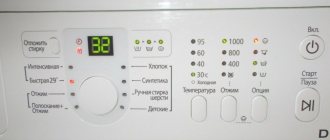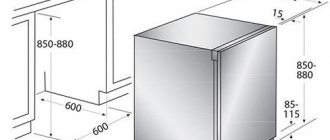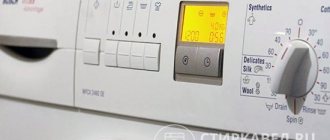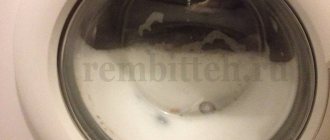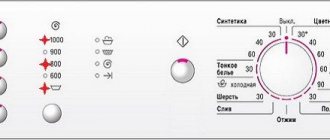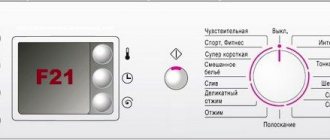Home pageArticlesPlumbing/IndoorsWhat types of protection against leaks are there in washing machines and dishwashers
Protecting washing machines from water leaks, we study the types, we understand the difference between complete protection and partial...
In this material, we will talk about the water leakage protection system used in washing machines and dishwashers. Such protection is not available on all models of washing machines and may be present in them as an additional option, an option for which the buyer will have to pay extra.
Various manufacturers of washing machines and dishwashers use a water leakage protection system - and each manufacturer gives this system its own name, for example Bosch or Siemens calls this system Aqua-Stop, and the name Aqua-Safe is used by Asco.
Giving different names to the system, the essence of the mechanism of action is not very different from each other. So, protection against leaks - it doesn’t matter whether it’s a washing machine or a dishwasher, their operating principle is the same. The leakage protection system can be divided into two types.
Why do you need Aquastop?
Dishwashers (DWMs), when working with water, are a source of danger - if a water leak occurs, problems cannot be avoided. The cause of a flood can be either a damaged hose or an internal failure accompanied by excessive water intake.
Flooding will cause damage not only to the owners, but also to the neighbors - if we are talking about an apartment building. Payments from lawsuits from injured residents can be many times greater than the cost of the appliances that caused the flood.
Whatever the cause of the leak, the machine should prevent it. The dishwasher itself regulates the supply and removal of water, relieving a person from controlling the washing process.
Advantages
Thanks to Aquastop, the dishwasher:
- without a human command, turns off the water intake;
- interrupts the washing program;
- de-energizes the dishwasher.
PMMs protected from water leakage have undeniable advantages:
- If the apparatus breaks down and water flows, a flood will not happen.
- You won’t have to pay your neighbors downstairs for a damaged ceiling or renovate your kitchen.
- Water is saved - it shuts off when triggered. But this, of course, is not such a big loss that can occur when neighbors are flooded from below.
- You can safely turn on the PMM at night and when leaving home.
- Preventing even greater damage that may occur due to flooding or short circuiting.
The flood is cancelled!
The main threat posed by a working PMM is water leakage. Flooding can be caused by a damaged hose or due to a serious internal failure where the unit takes in more water than it should. Leak protection technology is designed to protect equipment and its owners from such troubles: the machine independently regulates the supply and drainage of water, eliminating the need to vigilantly monitor the entire washing cycle.
A high-quality system increases the reliability of operation so much that the equipment can be safely switched to night operation mode - you do not have to worry about possible domestic disasters. The principle of operation largely imitates washing units, and the technology’s name, as a rule, also has a common name - “Aqua-Stop” (sometimes you can find the wording “Waterproof” and “AquaSave”).
What kind of protection is there?
Today, almost all dishwashers are protected from leaks - without this, the device becomes a source of big trouble. Different manufacturers may have different names for their systems. In PMM Electrolux and Bosch, for example, “Aquastop” operates.
Currently there are almost no dishwashers on sale without Aquastop. Even the cheapest machines have at least a tray with a float.
There are two types of flood protection - full and partial, let's look at them in more detail.
Partial
This option is twice as common. The housing and the pipe inside it are protected. The hose remains at risk.
Housing protection elements:
- tray - metal or plastic (located at the bottom of the device);
- sensor;
- mechanical valve;
- foam float, with lever.
Principle of operation:
- When water leaks appear, its level in the pan increases.
- The float, pushed outward by the water, changes the position of the lever that closes the switch.
- The sensor sends a signal to the valve relay - it shuts off the water supply, and to the module - it starts self-diagnosis. An error code appears on the screen - the user becomes aware of the problem.
- As soon as the signal arrives at the control module, the drain pump starts and begins pumping. From the tank, water is redirected to the drain.
- To restore the operation of the machine, you need to find out what is the cause of the leak and empty the pan.
If the hose located outside the housing is torn, everything will spill onto the floor.
Full
This option is much more effective than the previous one. It is often called “AquaControl”. With this system, the pan is equipped with a particularly durable fill hose, at the ends of which there are solenoid valves.
How does it work:
- When the water in the tank reaches a certain level, the sensor is triggered.
- Next, the system that protects against overflow turns off the valves and interrupts the connection with the water supply.
If the damage to the hose is accompanied by internal faults - for example, a sensor or pump is broken, the machine is protected by a pan with a float. And then the fight against flooding proceeds similarly to the previous version - the tank is emptied automatically and the problem is eliminated.
This option provides greater security, which is why it is worth choosing devices with this function.
To increase the safety of the PMM, you can buy and install a particularly reliable Aquastop hose. It is double - if the inner layer wears out, the outer one saves the situation.
With minor leaks, the system in budget and outdated PMM models does not work immediately. In good machines, Aquastop works immediately.
Partial protection against leaks
What is partial protection, let's figure out how it works. Machines with such protection against leaks are equipped with a special tray, for example, like the one in the figure.
A float equipped with an electric switch is installed inside the pan. The tray is made of plastic or metal, the float is made of polystyrene foam. When water flows inside the machine, it falls into the pan, with a certain amount of water the float rises and the switch is activated. At its signal, the machine switches to emergency mode, the washing process stops, the pump operates and pumps out the water.
Important! In such a situation, an error code is displayed on the machine’s display; different models have different symbols, for example, code E1 will appear in an LG machine, and E9 in a Samsung machine.
If water leaks into the pan, you need to pour water out of it, and then look for the cause of the breakdown and fix it. You can learn about all possible causes and elimination of leaks from the article on why a washing machine leaks.
Inlet hoses with valves
Washing machines with partial protection are called so because the protection is activated only when water flows into the machine. But if the hose breaks in some place outside, then flooding cannot be avoided. In this case, it is worth considering inlet hoses equipped with protection. They come in three types:
- The first type of hose is a regular hose placed in a durable corrugated casing. At one end of the hose, connected to the water supply, there is a built-in protective block with a peephole. Inside the block there is a plunger held by a spring. When the hose ruptures, water gets inside, the spring weakens and the plunger closes the flow of water. After which the eye becomes red.
Let's celebrate! The disadvantage of such a hose is that after activating the protection against water leakage, it will have to be completely replaced.
- The principle of operation of the second type of hose is generally no different from the first. The difference is that instead of a spring, inside the protective block there is a pair of magnets facing each other with the same poles. They are the ones who hold the plunger until water enters the protective block. This hose is also replaced after a leak.
- The third type of hose does not have a mechanical valve, but an electromagnetic one. While the machine is disconnected from the network, the plunger shuts off the water supply; as soon as the machine is turned on, the valve opens. The control wires in such a hose are hidden under a durable sheath.
For your information! The Aqua Stop inlet hose is designed for a pressure of 70 bar, which is 7 times the maximum pressure in the pipeline.
What to do after AquaStop is triggered?
There can be many reasons for the triggering:
- Water does not drain due to a clogged filter or drain. Or due to the failure of the drain pump.
- Uncontrolled water flow due to a faulty valve or torn hose.
- A malfunction of the Aquastop system is due to a detached hose, a broken float, or deformation of the pan.
Regardless of the reason for the triggering, you must act in this order:
- Unplug the dishwasher. Don't step in a puddle. If you cannot turn off the device without stepping into the water, it is better to turn off the electricity at the panel.
- Turn off the water valve in the bathroom.
Please note that it is unsafe to operate the machine once AquaStop has been activated. Diagnostics is necessary - the device must be examined by a technician, find out the cause of the leak and find its location. If necessary, blockages will be cleared, faulty parts will be replaced with new ones.
When all faults have been corrected, the system is activated by pressing the reset button. If necessary, a new Aquastop system is installed.
Purpose of the Aquastop system
In the pipelines supplying water to residential buildings, the pressure is quite strong. In addition, there are often cases of sudden water hammer. All this can lead to unexpected leaks. Aquastop is designed to protect dishwashers from this. It is a necessary part of the equipment and ensures its protection against leaks. The principle of operation of Aquastop in a dishwasher is similar to other devices that work with water. For example, washing machines have the same protection. In dishwashing equipment, the main function of the system is to turn off the water supply in a timely manner when leaks occur.
Of course, the presence of the Aquastop system does not guarantee complete protection against water leakage: according to statistics, in 8 cases out of 1000 it does not help. That is why it is better to protect yourself in advance and try to prevent possible problems than to eliminate the consequences of flooding later. To do this, it is enough to carry out preventive measures. These include regular cleaning of machine components - the filter, housing, lid seal and detergent dispenser. In addition, it is necessary to periodically check the integrity of the housing.
The dishwasher needs regular maintenance
conclusions
Let's summarize:
- In most budget PMMs, only the housing is protected from leaks. Higher-class machines often have a more efficient system - in addition to the body, they also protect the outer hose.
- The presence of 100% protection does not actually affect the cost of the dishwasher. It is all the more advisable to choose a model that will be completely protected from leaks.
- The criterion under consideration is not key when purchasing PMM. Typically, buyers pay attention to the design, price, loading, brand, number of baskets and other things that catch the eye or affect the cost/quality of the machine. But in vain. If a flood occurs, the losses may exceed the cost of the equipment.
If, when choosing a PMM, you prefer a model with 100% leakage protection, this will not greatly affect your wallet. But your dishwasher will be under complete control, and you will be insured against troubles associated with a flood.
Mechanical valves Aquastop
Separately, I would like to say about the so-called mechanical safety valves, positioned as a protection system against water leakage, and sometimes recommended for installation on washing machines and dishwashers. Their operating principle is quite simple, but their protection is questionable.
Inside the housing there is a movable valve held open by a special spring. As soon as the passing flow increases its speed (implying a break in the hose), the pressure on the valve increases and the spring, compressing under the increased flow of water, allows the valve to enter the seat and completely block the flow of water. I would like to say right away that such a system is very unreliable, since its correct operation is highly dependent on external water pressure and the speed of the water flow.
Such a valve will not shut off the water, for example, as a result of a partial rupture of the hose, water from which can flow for as long as desired without any reaction from the valve, since the valve will perceive the water passing through itself, like a normal water intake by a washing machine. Of course, if there is no protection against leaks at all, the use of such a valve according to the principle (at least something) is possible and will be justified, after all, the valve will, with some degree of probability, be able to protect against complete failure of the hose, and this in any case minimizes the risks.
You can read more about testing such a valve in another article.
Let me finish here, let your household appliances never let you down and only bring you joy.
Watch a video about leakage protection systems on the Smart Bill channel
Show more articles from the category - Plumbing
All models - in one catalog!
When choosing branded equipment in regular stores, you can only find some models. An online store specializing in large and small household appliances Smeg is a godsend for lovers of modern dishwashers and washing machines, hobs, refrigerators, ovens, stoves, hoods, and sinks. And if you already have enough large household appliances, choose a beautiful toaster, kettle or mixer in retro style!
All products presented on the site are covered by the manufacturer's warranty! Order any model with delivery to any region of the country right now!
Types of inlet hose protection
The industry produces special hoses with built-in mechanisms to shut off the water supply in various ways. There are the following systems that are responsible for protecting against unwanted leaks of the inlet hose:
- mechanical;
- using an absorbent;
- electromagnetic type.
The first option is now used very rarely, but you can find it on budget Bosch dishwashers. The system consists of a valve and a spring designed for a certain water pressure - if a leak occurs, it drops, the spring is activated and the valve shuts off the flow of water. Such a system is not able to recognize small leaks from a fistula or leaking gaskets, which can cause a lot of harm.
A system with a mechanical type Aquastop recognizes only 147 leaks out of 1 thousand, and this is only no more than 85% of protection, which today is considered much lower than the norm.
At its core, such a system works like one hose inside another, made of corrugated plastic: if the inner layer is damaged, then the plastic one will be quite reliable protection.
Mechanical type
When a leak occurs, the protection system is immediately activated - the red indicator on the housing lights up and the water is turned off.
The mechanical valve installed on the drainage device is unsuitable for further operation after operation due to failure of the hose. Therefore, a new drain hose is installed, which is the main disadvantage of such protection against leaks.
A protection system based on the use of an absorbent is used much more often, its operation is not complicated: moisture from a leak flows into a special reservoir with an absorbent, which instantly swells, expanding at the same time, thereby blocking the access of water to the dishwasher using a valve.
Using an absorbent
The main disadvantage is the fact that it is also disposable: the absorbent inside the body swells and hardens, tightly locking the valve, eliminating the possibility of reusing it, including the hose. Systems using an absorbent come with a plunger or only a spring; there are no others in world practice.
The electromechanical protection system with Aquastop works according to a similar scheme as the system with an absorbent, but its basis is an electromagnetic valve. The body of such a device may have one or two valves. Water flows through the hose into the pan of the Bosch machine, the device with the absorbent begins to absorb it, swells - the valve blocks the access of water to the machine.
Electromechanical protection system
The main problem with hoses with Aquastop is the impossibility of extending them or installing them in hard-to-reach places. Due to the dimensions of the rather massive body, connection to the tap can be very problematic. In addition, many users of Bosch machines claim that the housing must be installed with the arrow pointing down, so when installing, check your actions with the included instructions.

